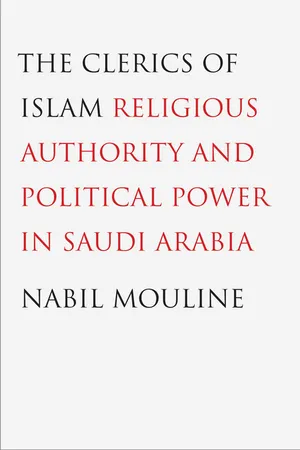
The Clerics of Islam
Religious Authority and Political Power in Saudi Arabia
- 344 pages
- English
- PDF
- Available on iOS & Android
The Clerics of Islam
Religious Authority and Political Power in Saudi Arabia
About this book
Followers of Muhammad b. 'Abd al-Wahhab, often considered to be Islam's Martin Luther, shaped the political and religious identity of the Saudi state while also enabling the significant worldwide expansion of Salafist Islam. Studies of the movement he inspired, however, have often been limited by scholars' insufficient access to key sources within Saudi Arabia. Nabil Mouline was granted rare interviews and admittance to important Saudi archives in preparation for this groundbreaking book, the first in-depth study of the Wahhabi religious movement from its founding to the modern day. Gleaning information from both written and oral sources and employing a multidisciplinary approach that combines history, sociology, and Islamic studies, Mouline presents a new reading of this movement that transcends the usual resort to polemics.
Frequently asked questions
- Essential is ideal for learners and professionals who enjoy exploring a wide range of subjects. Access the Essential Library with 800,000+ trusted titles and best-sellers across business, personal growth, and the humanities. Includes unlimited reading time and Standard Read Aloud voice.
- Complete: Perfect for advanced learners and researchers needing full, unrestricted access. Unlock 1.4M+ books across hundreds of subjects, including academic and specialized titles. The Complete Plan also includes advanced features like Premium Read Aloud and Research Assistant.
Please note we cannot support devices running on iOS 13 and Android 7 or earlier. Learn more about using the app.
Information
Table of contents
- Contents
- Introduction: The Ulama, Clerics of Islam
- 1. The Birth of The Hanbali Tradition
- 2. Shedding New Light on the Life of Muhammad Ibn Abd Al-Wahhab
- 3. Hanbali-Wahhabism in the Nineteenth Century: Grandeur and Decadence
- 4. The Birth of a Kingdom and the Renaissance of a Tradition
- 5. Routinization and Institutionalization of Hanbali-Wahhabism
- 6. The Committee of Grand Ulama: An Organization in the Service of the Prince . . . and the Population
- 7. Raising the Veil on the Conditions of Access to the Religious Establishment
- 8. Religious Authority in Practice: The Promotion of Virtue and the Prevention of Vice
- 9. At the Crossroads: The Religious Establishment Put to the Test of the Saudi Politico-Religious Space
- Conclusion
- Appendix: House of Saud and Map of Saudi Arabia
- Notes
- Bibliography